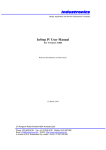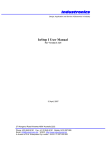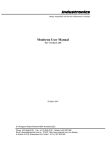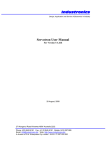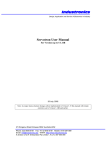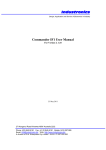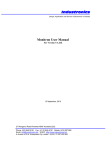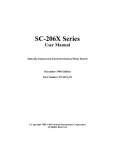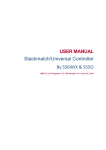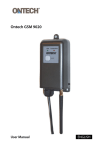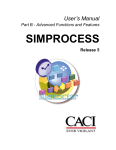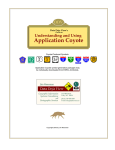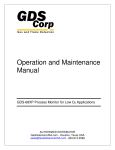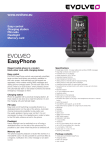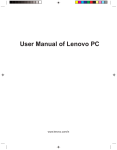Download InStep IV User Manual HW Rev 1
Transcript
Industronics Design, Application and Service of Electronics in Industry InStep IV User Manual For Version I 5.07 Relevant for hardware revision 1 Refer to Rev. 0 manual for versions prior to I5.06C 29 April, 2014 27 Wanganui Road Kirrawee NSW Australia 2232 Phone: (02) 9545 6181 Fax: +61 2 9545 6181 Mobile: 0419 267 889 Email: [email protected] WWW: http://www.industronics.biz A division of D.H. Enterprises Pty Limited A.B.N. 72 087 000 995 Industronics InStep IV User Manual HW Rev 1.doc Note: In order to simplify the manual, this manual covers only the Revision 1 hardware and later and firmware versions from I5.06C on. For Revision 0 hardware and earlier versions please refer to the earlier Rev. 0/1 manual. Overview The InStep IV control module is intended to be used in conjunction with a stepper drive and motor or a servodrive with step input and a servomotor. It provides stop/start registration control of processes such as self-adhesive labelling, overprinting etc. This operation can be speed synchronised with another operation such as the product conveyor or printing machine. It is housed in a DIN rail mountable enclosure. The enclosure can be opened by operating two small catches to enable the user to configure the unit via several jumpers located inside. This allows for diversified applications while maintaining the same hardware minimising the need for several units to be kept for spares. The enclosure has 16 screw terminals and a five way bus connector on the bottom. The bus has two connections for the RS-485 half-duplex communications bus, two connections for a differential master encoder input and one connection for ground. Up to 32 units may be daisy chained or multi-dropped to allow a user interface/PLC to control several axes of motion. All inputs are independently jumperable to change their polarity for use with either sinking (NPN) or sourcing (PNP) input devices. The outputs can be changed for sinking or sourcing type but all must be the same type. The amount of I/O available is in fact limited by the terminals fitted to this enclosure and an expansion board is available which will plug onto the existing board and then fit into a wider enclosure that has 24 terminals. This provides more I/O and many other options. There is a green and a red LED on the front. The green LED is to indicate that the internal 3.3V supply is functional and the red LED indicates status. In order to minimise the amount of firmware versions two of the input terminals have jumpers which can select 1 of 3 available input signals and two of the output terminals can be jumpered to one or more of 4 available output signals. Also there are 8 jumpers to select various options. Three of these are used to select the unit’s address on the multidrop network. Wiring Power A power supply of between 12 and 28 volts DC is required to be connected to terminals 1 and 2. The total power requirement is 100mA plus input and output currents. Inputs All input are required to either sink or source between 5 and 12mA at between 12 and 28 volts DC. The master encoder input is five volt differential RS-422/RS485. Refer to jumper description table to select polarity of inputs. Outputs All outputs can sink or source up to 100mA each at the same voltage as supplied to the power supply terminals. The STEP output is five volt differential RS-422/RS485. Refer to configuration section for changing polarity. To change between NPN & PNP outputs the output IC and associated jumpers must be changed. Serial Communications The serial communications via the bus connector is two wire (half-duplex mode) only. Rev. 1 provides for one RJ45 socket to be optionally fitted for communications and power. Page 2 of 22 Industronics InStep IV User Manual HW Rev 1.doc Configuration Configuration consists of selecting the appropriate jumpers for your application and installing the appropriate output driver IC in position IC9. The jumpers are fully explained in the jumper description table. The unit is normally supplied with an NPN output driver IC, however it can be ordered with a PNP type or changed in the field. The correct IC for NPN outputs is ULN2801A (Rev. 0) and ULN2803A for Rev. 1. PNP for Rev. 1 only is UDN2981A. Be sure to set jumpers J9 and J10 correctly to match the installed IC or damage will result! Mounting The InStep module can be mounted on 35mm DIN rail and should be mounted with terminals 1 to 4 uppermost and the rail clip at the bottom. If the InStep module is disassembled to facilitate the changing of jumpers etc, it should be reassembled so that terminals 13 to 16 are at the rail clip end of the housing. If the module must be mounted on a vertically mounted DIN rail it should be mounted with terminal 1 lowermost. This would place the side label uppermost. Serial Communications Up to 32 modules may be daisy chained together to allow one master device to communicate with all units using only one communication port. The address of each unit is selected via the first three jumpers on the option port. Commands are issued by the master device in the system and the modules either simply act on this command or respond if it was a query type command. All messages to and from the InStep modules have the following field format: Header, Address, Command, Optional value, Carriage return and an optional checksum. e.g.; 1[0]P2AB<CR>[CHK] Where, • The semicolon character (3B hex) is the header. All messages on the network begin with this header character. • 1 is the destination address on the network. The PLC or computer, etc is always address zero. Jumpers on the Option Port set the address of the InStep units. The valid range is 1 to 8 ASCII. • [0] is the senders address in ASCII. This field is optional and is selected along with the checksum. • P is the command. All messages from the master have this field. All responses from the InStep modules do not have this field. Refer to the InStep Command Summary for more details • 2AB is the value. Whether this field exists and its width depends on the command. All responses from the InStep modules have this field. • <CR> is the message terminator. All messages are terminated by a carriage return (0D hex) character. • [CHK] is a message checksum. It is the two’s complement of the preceding bytes. This field is optional but must/will be present if it is selected at bit 5 of OPTION2. Some commands are queries only and so no value field is allowed. Some command values are in decimal ASCII others are in hexadecimal ASCII. All response values are in hexadecimal ASCII. All hex digits A to F must be in upper case. Leading zeroes are not required in commands but are tolerated. Leading zeroes are always returned to the width of the value field. Space and Line Feed characters in commands are ignored. Responses are always directed to address zero. By setting bit 4 of OPTION2, commands that do not expect a response and successful setting type commands can be made to return an <ACK> character. Out of range data or invalid commands will result in a <NAK>. When this is not set, or prior to I5.04, the only response is the result of the query or a ‘?<BEL>’ to indicate an error. Out of range characters in data will cause unpredictable results. (i.e. other than 0 to 9 and A to F) A semicolon anywhere in the command string (except the checksum position) will clear the input buffer and start a new command/query reception. Previously the semicolon header was only scanned for after the previous string was terminated by a carriage return. This meant that if a carriage return was garbled or lost the next string would be appended to the previous one and both then ignored, as it would be an invalid string. Also the backspace character (08) will delete the previous character sent. This does not apply to the header or address characters! Page 3 of 22 Industronics InStep IV User Manual HW Rev 1.doc Command Descriptions A - Advance Function Range Default Description Sets the advance value or queries the current value. ? (See Desc.) to 65,535 decimal in command, 0 to FFFF hexadecimal in response. 300 (12C hex). This command sets the number of steps to move after the gap sensor has activated. If a value is entered that is less than the decel (F command) setting the stored value will be equal to the decel setting. If the decel is adjusted this value must be entered again to adjust the entered advance value. If the speed compensation is selected on the option port, it is necessary to observe minimum values of advance so that the compensation can function correctly. The amount of compensation varies with the speed (higher speed more compensation, maybe up to 200 steps). In addition to this there must be sufficient advance to do the deceleration which may be up to 100 steps depending on the speed. Changing the advance value will reset the missing label length and restart the auto-teaching function. B - Batch Count Not implemented yet (Temporary use implemented) Function Range Default Description Sets or queries the batch counter. (Sets fixed move length). 0 to FFFFFF hexadecimal. (0 to 65,535 dec in command, 0 to FFFF hex in response). 0 This command forces a value into the batch counter register. Normally used to reset the count. (Sets the length in steps of the move done when the fixed move mode is activated). C - Total Count Function Range Default Description Sets or queries the total label counter. 0 to 99 decimal 0 This command forces a value into the total counter register. Normally used to reset the count. Counter only counts to 99 then rolls over back to 0. It is up to the master controller to extend this count to a larger number by periodic polling. D - Coder Delay Partial implementation Function Range Default Description Sets or queries the coder delay. 0 to FFFF 0 This command sets the delay in steps between either the start of dispensing or the stopping and the print signal coming on depending on the type of batch coder selected. At the moment 0 disables and any value enables with a small delay. Any odd value causes checking for a printer OK signal at IN4, even values look for a printer faulty signal. E - Enable Function Range Default Description Enables the dispensing of labels. 0 or 1 Depends on state of J28. (Refer to Option Port Table) When set to 1 enables the dispensing of labels at the next product sensor activation or when set to 0 disables the dispensing of labels at the end of the currently dispensing label. Also used to reset faults. Page 4 of 22 Industronics InStep IV User Manual HW Rev 1.doc e – End of Reel Setpoint Function Range Default Description Sets or queries the setpoint of the End of Reel counter. 0 to FF 3 How the “end of reel count” functions is determined by bit 6 in Option2. With this bit on, the setting here is the number of labels that can be dispensed in between operations of the ‘end of reel’ sensor. The sensor detects the movement of the label reel. In this mode, the number set here is usually quite low. With the bit off, it sets the number of labels that can be dispensed after the ‘end of reel’ sensor activates. The sensor detects that the label reel is low in diameter. The setting is usually larger in order to allow the reel to become very close to finished before the head stops. In both modes, the setting depends on the label length. F - Forward label Not implemented yet (Temporary use implemented) Function Allows the labeller to skip over a missing label to prevent one product not being labelled. (Number of Deceleration Steps during end of advance.) Range 0 to FF Default 0 or off (100) Description The number of labels between the gap sensor and the peeler bar is set here. When the missing label approaches the peeler bar a double length index is performed to skip over the missing label allowing all products to be labelled. (Temporarily used for number of deceleration steps. Re-enter advance after changing this value!) As of Ver. 5.05 this decel setting is disabled. You can still request the current setting. Do not adjust this value! f – Fault Status Function Range Default Description Allows the query of the reason for the last disable 0 to FFFF N/A Refer to the Red LED Flash Code table for the correlation between the value returned here and the reason for the disable. G - Manual Dispense (Go) Function Range Default Description Starts the label sequence independent of the product sensor. No value allowed! N/A This command allows the operator to dispense a label without having to operate the product sensor. Any product delay is bypassed and only one label is dispensed if in two label mode. Also if the master is stopped the label will be dispensed at the set speed rate. H - Batch Preset Not implemented yet Function Range Default Description Sets or queries the batch preset value. 0 to FFFFFF hexadecimal 0 or off This command sets the count at which the batch counter will activate the output and reset the counter. I - Input Port Status Function Range Default Description Returns a value indicating the status of the input port. No value allowed! N/A This command returns two hex digits representing the status of the 8 bit input port. A value of 00 is all off. Refer to the port assignment tables for the function of each input. Page 5 of 22 Industronics InStep IV User Manual HW Rev 1.doc J - Jig Delay/Blanking Mode Function Range Default Description Sets or queries the jig delay or blanking mode. 0 to 65,535 decimal in command, 0 to FFFF hexadecimal in response. 0 or off This command sets the steps between product detection and activating the jig solenoid output. A value greater than zero enables Jig Control Mode. If you select this mode you must select a mode with the ’U’ command as well! As of version 5.05E setting this command to 1 enables blanking mode rather than Jig Control mode. See “j” command below. j - Jig Hold Delay/Blanking Length Function Range Default Description Sets or queries the jig hold delay. 0 to 65,535 decimal in command, 0 to FFFF hexadecimal in response. 0 or off In Jig Control Mode this command sets the length between the dispense stopping and the deactivation of the jig solenoid. It is up to the operator to ensure correct product spacing. You must ensure the product is released before the following product is detected by the product sensor or that product will be ignored. In Blanking Mode this setting sets the length that the product sensor is ignored for after the label stops. In addition when blanking mode is set, the product sensor is re-confirmed to be on at the completion of the product delay. If only this product sensor confirmation is required, simply set a very short blanking length. Blanking is useful when the trailing edge of the product has a possible second trigger point because of a hole or handle etc. The product sensor re-confirmation is very good for preventing false dispenses caused by product sensor activation while the machine is stopped. This setting is only used when in Jig Control Mode or Blanking Mode which is enabled by the J command above, so you can leave the value in here always. K - Air Blast Time Function Range Default Description Sets or queries the air blast time. 0 to 255 decimal in command, 0 to FF in response. 0 or off This command sets the air blast time in milliseconds. The air blast is for machines with an air box attachment. The air blast time occurs after the product delay and before the label starts to move. L - Length Measuring Function Range Default Description Turns the length measuring function on or off. 0 or 1 0 or off This command turns the length measuring function on (1) or off (0). When turned on the number of steps to dispense the label is transmitted to the master device shortly after the label is dispensed. Value returned is number of steps in hexadecimal. l – Average Length Function Range Default Description Displays the average length in steps. No value allowed! 0000 hex This command can be used to determine whether the automatically calculated missing label length is in use and what the average dispense length is. When the unit is first powered up the value will be zero. Also it can be reset by a change to either the advance value (A)/t) or six consecutive labels have been dispensed that are all more than 3mm different from the current value. Page 6 of 22 Industronics InStep IV User Manual HW Rev 1.doc M - Master Speed Function Range Default Description Queries the speed of the master encoder. No value allowed! N/A This command allows the user to check the operation of the master encoder. To convert the value returned into a rate in kHz, divide the lowest 4 digits into 1250 decimal. i.e. Speed (kHz) = 1250/Value. If value is 1F4 then 1250/500 = 2.5kHz. Note: This is the time between the last two encoder pulses so when the encoder has a stopped a value will still be indicated. The returned value is actually 6 digits of hexadecimal, the first digit indicates whether of not the master is considered as stopped or not. (1 = stopped and so value is invalid, 0 = running and value following is valid). The second digit is used internally to detect a stopped condition. It will normally show 8 except at extremely low encoder rates. N - Missing Label Length Function Range Default Sets or queries distance required to trip on missing label fault. 0 to 65,535 decimal in command, 0 to FFFF hexadecimal in response. <I5.05Y is 48 (12,288 steps), I5.05Y & I5.06 is 64 and >I5.06 is 80 (20480 steps or 620mm at 33p/mm or 1.024m @ 20p/mm) Description The missing label function can work in either of two ways: If the value entered here is less than 128 (63 prior to I5.03) the missing label function works as before except that the number of steps is set differently. The number of steps at which the labeller will stop is 256 times the value set here. So a value of 16 gives the same as the old default value of 5 (256 x 16 = 4096). This gives a much more precise way to set the trip point. If the value is greater than 127 the “no gap skip” style of missing label is implemented. This allows the labeller to skip past missing labels (or blocked label gaps) as if they never happened. Since I5.05J and L (not K) auto-teach missing label is implemented. This automatically sets this value. As there is no way at the moment to switch off auto-teach setting this value is not very useful. A value of 0 here disables the missing label function and the motor will run works by simulating the label gaps presence at the number of counts specified here. So the number entered here should be the label length minus the label advance setting. If the actual gap occurs after the gap is simulated, the actual gap position will override the simulated one to maintain correct registration. If you change the advance after setting this value you should redo this setting to cater for the new advance value. If the “gap skip” is done four times consecutively the labeller will disable and turn on the Missing Label and Bussed Fault Outputs. Also, refer to L command. Note forever if no gap is seen. 0 also stops auto-teaching of this setting as of version I5.05P. Care must be exercised when using low values of advance at high speed. As the gap is ignored after the web starts to decelerate it is possible that no correction is done when the gap comes along after the gap has been simulated and deceleration has already started. O - Output Port Status Function Range Default Description Returns a value indicating the status of the output port. 0 to FF hexadecimal N/A This command allows the user to force the state of the output port bits. As a query it returns two hex digits representing the status of the 8-bit output port. A value of 00 is all off. Refer to the port assignment tables for the function of each output. Page 7 of 22 Industronics InStep IV User Manual HW Rev 1.doc P - Label Position Function Range Default Description Sets or queries the label position value. 0 to 65,535 decimal in command, 0 to FFFF hexadecimal in response. 0 This command sets the delay in steps between the product sensor activation and the start of dispense effectively changing the position of the label on the product. Q and q - Stop Dispense (Quit) Function Range Default Description Used to stop the dispense of a label. No value allowed! N/A This command stops the label dispense independent of the gap sensor. ‘Q’ simulates the gap sensor signal; ‘q’ causes instant deceleration and stop (i.e. no advance). R - Ramp Select Function Range Default Description Sets or queries the acceleration ramp. 0 to 13. 4. This command selects 1 of 14 acceleration ramp profiles. A value of 13 is the softest. The acceleration profiles are performed over the following number of steps. Ramp Number 0 1 2 3 4 5 6 7 8 9 10 11 12 13 Number of Steps 10 15 20 30 40 50 60 75 85 100 125 150 175 200 r – High Page Register Read Function Returns the value stored at the specified High Page Register address. Value in command is an index added to 1800 hexadecimal Range 0 to A hexadecimal in command as index, no data is latched SRS. 0 to FF returned as data. Default N/A Description This command is for debugging purposes only and requires an intimate knowledge of the MPU hardware to interpret the responses. Page 8 of 22 Industronics InStep IV User Manual HW Rev 1.doc S - Set Speed Function Range Default Description Sets or queries the set speed 0 to 9999 in command, 0 to FFFF hexadecimal in response. 120 hex (2:1) 200 hex (1:1, J29 on). This command sets the speed of dispensing when no master encoder is used. Sync ratio of zero must be set for this value to take effect. Also this value will be used if a manual dispense is done with the master stopped. A value in the 9000’s is typical with a larger number being a faster speed. If J29 is on the default is 200hex (S9537) or when off it is 120hex (S9761). The returned value is not scaled! T - Two Label Spacing Function Range Default Description Sets or queries the two label spacing value 0 to 65,535 in command, 0 to FFFF in response. 0 or off This command sets the number of steps to pause between the first and second label of a set. A value of 0 turns this function off. Note that as of V 5.05D there is a minimum spacing caused by the deceleration/acceleration between the two labels. Prior to this version the first label stopped with no deceleration and the second started with no acceleration t - Two Label Spacing Advance Function Range Default Description Sets or queries the two label spacing advance value 0 to 65,535 in command, 0 to FFFF in response. 300 (12C hex.) This command sets the number of steps of advance for the first label of a two label set. This is set the same as ‘A’ if the labels are the same size in the set and often different if the labels are different lengths. Note that labels of different lengths in a two label set causes confusion for the auto setting missing label as it does not measure the two labels separately. This will be upgraded in the future. U – Spin Up Delay Function Range Default Description Sets or queries the spin up delay. 0 to 65,535 in command, 0 to FFFF in response. 0 or off This command can enable one of two modes. A value of 1 puts the InStep into “Jig Only Mode”. In this mode the normal product sensor is ignored and the sequence is started by the “Jig In” input. When a larger value is entered, the “Orient Jig Mode” is turned on. This command sets the number of steps to pause before the registration scanner is enabled. This is to ensure the product is spinning in the jig at the correct speed. In orient jig mode the normal product scanner is ignored and the cycle is initiated by a sensor connected to the “Jig In” input. This initiates the spin up delay. When this is complete, the sensor connected to the “Colour Sensor” input is enabled. When the colour sensor sees a leading edge the normal dispense sequence is started. A value of 0 turns both jig modes off. u - Option Port 3 Function Range Default Description Sets or queries the Option3 port status. 00 to FF. 00. Two hex digits representing the status of the 8-bit option3 port. A value of 00 is all off. Bit 0 – Fixed Pull Mode. Only bit 0 is used at this time. Setting the other bits will have no effect. Page 9 of 22 Industronics InStep IV User Manual HW Rev 1.doc V - Version Function Range Default Description Queries the version number of the installed firmware. No value allowed! N/A This command returns the installed firmware’s version number in the following format: A letter to indicate the type. A major version number followed by a decimal point. Two minor version digits to indicate revision level. A space or letter to indicate special versions. v – Serial Number Function Range Default Description Queries the serial number of the device. No value allowed! N/A This command returns the serial number in the following format: A letter to indicate the number or versions this unit has had. (A is original) The serial number in decimal in a fixed six digit format. W - Option Port (DIP Switch) Function Range Default Description returns a value indicating the option port status. No value allowed! N/A Returns two hex digits representing the status of the 8-bit option port, refer to the port assignment tables for the jumper functions. A value of 00 is all off. Also used to load a new setting. Bit 0 corresponds to J24. w - Option Port 2 Function Range Default Description Sets or queries the Option2 port status. 00 to FF. 00. Two hex digits representing the status of the 8-bit option2 port. A value of 00 is all off. Bit 7 – Output frequency equals input frequency. 0 is normal Out = In x 2 (Double) Bit 6 – End of Reel Mode. When on selects reel turning detection type and when off selects reel diameter low or no web type detection. Set to 0 if no end of reel sensor is fitted. Bit 5 – Use Checksum. When set it is necessary to send a two’s complement checksum byte after the <CR> byte. Responses will then include this byte also. Bit 4 – Acknowledge mode. <ACK> and <NAK> sent/expected. Bit 3 – Stepper Boost. When on changes the servo enable output function to a stepper drive boost. Bit 2 – Servo OK input polarity. 0 is Off = OK. 1 is On = OK. Bit 1 – Orientation Error Enable. Bit 0 – Gap Sensor Gate Mode. (I5.05H) was Fixed Pull Mode prior to this. X - Examine RAM Function Range Returns the value stored at the specified RAM address. 0 to 9FF hexadecimal in command as address, 0 to FF returned as data. The range for address is limited by the MPU. GT16 = 47F, GT16A = 87F Default N/A Description This command is for debugging purposes only and requires an intimate knowledge of the firmware to interpret the responses. Page 10 of 22 Industronics InStep IV User Manual HW Rev 1.doc Y - Synchronisation Ratio Function Range Default Description Sets or queries the sync ratio 0 to 255 decimal in command, 0 to FF in response. 128 decimal (80 hex) or 100% This command sets the sync ratio between the master encoder and the output pulse rate FF is 50%, 10 is 800% Refer to table for correct value. A value of 0 causes the master encoder to be ignored and the set speed value to take effect. Z - Internal Port Function Range Default Description Returns a value indicating the internal port status or can force output bits. 0 to FF N/A Returns two hex digits representing the status of the 8 bit internal port, refer to the port assignment table for individual bit functions and states. A value can be written to the port in order to force the state of the output bits on that port, the input bits remain unaffected. [ - Write RAM Function Range Writes the specified data into the specified RAM location. 0 to 9FF hexadecimal in command as address, 0 to FF returned as data. The range for address is limited by the MPU. GT16 = 47F, GT16A = 87F Default N/A Description This command has a special data format, there are two data fields separated by a comma. The data in front of the comma is the address to write to and the data after the comma is the data to be written. This command is for debugging purposes only and requires an intimate knowledge of the firmware to use it successfully. Inputs All inputs are selectable for NPN (1 to 2) or PNP (2 to 3) input devices. The function of each input follows. PRODSENS - Product Sensor This input initiates the labelling sequence. It starts with a transition from off to on of this input. See jumper J7 for input polarity selection. Terminal 9 on a standard InStep. GAPSENS - Gap Sensor This is the registration input. It is normally connected to a fork sensor that detects the gap between the labels on the backing paper. The label advance starts counting with an off to on transition of this input. See jumper J8 for input polarity selection. Terminal 10 on a standard InStep. Master Encoder This is where the encoder for the product speed is connected. The encoder is usually coupled to the conveyor, turret or vacuum belt of the machine. The pulses per rev of the encoder and its gearing to the conveyor / belt should be selected so that the rate is the same as the step rate of the motor. It is best to be on the low side of one to one if this cannot be achieved. The encoder should have a 5V differential output and is connected to the buss connector, usually via a HeadUnit. The HeadUnit also allows for the correct scaling of the encoders pulse rate. If the /G option is fitted the encoder should have a 24 volt NPN/PNP output. The connection is then Terminal 11. Page 11 of 22 Industronics InStep IV User Manual HW Rev 1.doc IN1 – Colour Sensor (Product Sensor 2) This input only functions in Orientation Mode. It triggers the labelling cycle just as the normal product scanner does however only after the orient part of the cycle is complete. See jumper J1 for input polarity selection. Terminal 5 on a standard InStep. IN2 – Jig In Sensor/Product Gate/Gap Sensor Gate This input is usually a proximity detector mounted on the orientation jig to indicate when the jig is closed. It initiates the spin up delay in orient jig mode. If option port jumper J31 is installed this input becomes the product sensor gate input. In this mode this input must be on before a product detection will start the dispense cycle. If bit 0 of ‘w’ command is set this input becomes a gate signal for the gap sensor. See jumper J2 for input polarity selection. Terminal 6 on a standard InStep. IN3 – End of Reel This input is either connected to a sensor that detects a low diameter of labels on the unwind reel or one that pulses as the unwind reel turns. Refer to the description of ‘e – End of Reel Setpoint’ menu. See jumper J3 for input polarity selection. Terminal 7 on a standard InStep IN4 – Printer OK This input is connected to the printer OK/fault output of the printer controlled by the InStep module. When the printer is enabled by the Coder Delay (D) command with an odd value this input must be on otherwise the InStep is disabled and the bussed fault output is turned on. If an even value is used in D the input must be off for printer OK. The printer fault input is only checked just after the label dispense is completed. This allows it to possibly serve as an actual print confirmation input (from a contrast scanner for instance) or just a simple printer fault signal monitor. See jumper J4 for input polarity selection. On a standard InStep, J21 controls which terminal this signal is connected to. 1 to 2 is terminal 8, 2 to 3 is terminal 16 (when J38 is 1 to 2). IN5 – Servodrive OK This input is connected to the OK or fault output of the servo/stepper drive. See Option2 command for input polarity setting. It stops and disables labelling when changes to the selected faulty state. This input is only checked when labelling is enabled. When faulty the drive pulses are stopped and the drive enable is dropped immediately. Previously it was only done at the end of the dispense cycle. J22 controls which terminal this signal is connected to. 1 to 2 is terminal 8, 2 to 3 is terminal 16 (when J38 is 1 to 2). IN6 - Disable (Bussed Fault In) This input disables the labelling when on. It is normally used in the “bussed” mode where jumper J34 on InStep (or J60 on the Expansion Board) is installed. When several units are connected together via their IN6 or OUT7 terminals all units will be disabled when a fault occurs on any one unit. See J6 for input polarity selection. On a standard InStep J23 controls which terminal this signal is connected to. 1 to 2 is terminal 8, 2 to 3 is terminal 16. Note: IN6 and OUT7 polarities must be the same and on InStep J20 and J23 must be set correctly to bring them out to terminals. Page 12 of 22 Industronics InStep IV User Manual HW Rev 1.doc Outputs All outputs are selectable for NPN or PNP however they must all be one or the other. Selection is made by changing IC9. For NPN use ULN2803. PNP uses UDN2981A. Jumpers J9 and J10 must be set to suit. STEP – Step Signal This differential output is used to drive the pulse input of the stepper or servo drive. Terminal 11 is A/ and terminal 12 is A. If jumper J37 is set 1 to 2 the STEP signal is available as an open collector NPN signal on terminal 3. If using the differential output to the drive, J37 should be set 2 to 3. OUT1 – Coder This output is the start trigger for a date coder etc. Jumper J27 selects whether the coder is of the type that prints while the web is stationary (e.g. hot stamp) or moving (e.g. ink jet). Terminal 13 on a standard InStep. OUT2 – Servo Enable This output is used to enable/disable a servo/stepper drive when a fault occurs or it is commanded so. Terminal 14 on a standard InStep. OUT3 – Poor Registration This output is turned on when it is detected that the dispense length is inconsistent. It is turned back off when the dispense length returns to being consistent. This was Missing label prior to I5.07, use OUT7 now. Terminal 15 on a standard InStep. OUT4 – Jig Solenoid This output connects to the solenoid that controls jig closure. J17 controls which terminal this signal is connected to. 1 to 2 is terminal 16, 2 to 3 is terminal 4 OUT5 – Air Blast This output is turned on when an air blast time is entered with the K command at the end of the product delay and before the servo starts to move. J18 controls which terminal this signal is connected to. 1 to 2 is terminal 16, 2 to 3 is terminal 4. OUT6 – Air Assist This output is turned on at the start of the servo moving and off at the beginning of decel. J19 controls which terminal this signal is connected to. 1 to 2 is terminal 16, 2 to 3 is terminal 4. OUT7 – Bussed Fault Out This output is turned on when there is a fault. Please refer to the table for all the faults. Fault code 02 and greater will turn the output on. The enable command clears the faults. This output can be tied to input 6 with J34 on a standard InStep to implement the “bussed fault” mode. J20 controls which terminal this signal is connected to. 1 to 2 is terminal 16, 2 to 3 is terminal 4. OUT8 – Rewind Inverter Enable This output is used to control an inverter that controls the waste rewind motor. With J37 set to 2 to 3 this signal is available on Terminal 3. Page 13 of 22 Industronics InStep IV User Manual HW Rev 1.doc Tables InStep Command Summary Command A B C D E e F f G H I J j K L With Data Sets Label Advance Sets Batch Count Sets Total Count Sets Coder Delay Sets Enable On or Off Sets EOR Setpoint Sets Forward Label Count Returns ?<BELL><CR> Returns ?<BELL><CR> Sets Batch Preset Returns ?<BELL><CR> Sets Jig Delay Sets Jig Hold Delay Sets Air Blast Time Sets Length Measure On or Off or sets mislab value Returns ?<BELL><CR> Returns ?<BELL><CR> Sets Missing Label Length Sets Output Port Bits Sets Label Position Returns ?<BELL><CR> Returns ?<BELL><CR> Selects Acceleration Ramp Returns High Register value Sets Set Speed Sets Two Label Spacing U u V Without Data Returns Advance Value Returns Batch Count Returns Total Count Returns Coder Delay Returns Enable Status Returns EOR Setpoint Returns Forward Label Value Returns reason for disable. Manual Dispense (Go) Returns Batch Preset Value Returns Input Port Status Returns Jig Delay Returns Jig Hold Delay Returns Air Blast Time Returns Length Measure Status Returns Average Length Returns Master Speed Returns Missing Label Status Returns Output Port Status Returns Label Position Value Manual Stop Dispense (Quit) Manual Instant Stop Returns Selected Ramp Returns latched SRS register Returns Set Speed Returns Two Label Spacing Value Returns Two Label 1st Label Advance Returns Spin Up Delay Value Returns Option Port 3 Status Returns Firmware Version v Returns Serial Number Returns ?<BELL><CR> W w X Y Z Returns Option Port Status Returns Option2 Status Returns ?<BELL><CR> Returns Sync Ratio Returns Internal Port Status Returns ?<BELL><CR> Sets Option2 Port Returns RAM value Sets Sync Ratio Sets Internal Port Output Bits Write data to RAM location Returns ?<BELL><CR> l M N O P Q q R r S T t [ Any Other Returns ?<BELL><CR> Returns ?<BELL><CR> Sets Two Label 1st Label Advance Sets Spin Up Delay Sets Option3 Port Returns ?<BELL><CR> Page 14 of 22 Data Range 0 to 65535 0 to 65535 0 to 99 0 to FFFF 0 or 1 0 to 255 0 to FF 0 to FFFF N/A 0 to FFFFFF 0 to FF 0 to 65535 0 to 65535 0 to 8191 0, 1 or 2 Default 300 dec. 0 N/A ? 0 3 100 dec. N/A N/A 0 N/A 0 0 0 0 0 to FFFF 0 to 1FFFFF 0 to 65535 0 to FF 0 to 65535 N/A N/A 0 to 13 0 to A 0 to 9999 0 to 65535 N/A N/A 80 dec. N/A 0 N/A N/A 4 N/A 9743 d 0 0 to 65535 300 dec. 0 to 65535 00 to FF A0.00 to Z9.99Z A000000 to Z999999 0 to FF 0 to FF 0 to 9FF 0 to 255 0 to FF 0 0 N/A N/A 0 N/A 128 dec N/A 0,0 to 9FF,FF N/A N/A Industronics InStep IV User Manual HW Rev 1.doc Option Port Assignment Option Number 1 2 3 4 5 6 Jumper Number J24 J25 J26 J27 J28 J29 7 8 J30 J31 Description Notes Address Bit One Address Bit Two Address Bit Three Coder Type Select Enable State On Power Up Select Select Direct coupled motor or 2:1 belt drive. Speed Compensation Factor Product Sensor Gate Refer address selection table Refer address selection table Refer address selection table On = Moving Type 1 On = Enabled at power up On = Direct, Off = 2:1 belt drive. On is 20 pulses per millimetre, Off is 33. On = Apply for Servodrives On = Gate sig Req’d on IN2. Input Port Assignment Input Number 1 2 3 4 5 6 7 8 Description Colour Sensor Jig In Sensor / Prod Gate End of Reel Proximity Printer OK Servo OK Disable (Bussed Fault In) Product Sensor Gap Sensor Terminal Number 5 6 7 8/4 8/4 8/4 9 10 Notes Orient Mode Only Orient Mode / J31 / ‘w’ command Refer to the ‘e’ & ‘w’ commands Monitor Printer Status Monitor Servo Status Linked to Output 7 by J34 Product detection Sensor Label Gap Sensor Output Port Assignment Output Number 1 2 3 4 5 6 7 8 Description Coder Servo Enable Poor Registration Jig Solenoid Air Blast Air Assist Bussed Fault Out Rewind Inverter Enable Terminal Number 13 14 15 16/4 16/4 16/4 16/4 3 1 Notes Refer to Note 1 On = Missing label Fault Requires J37 set 2 to 3. When moving type coder is selected and enabled via the D command, the output will come on just after the acceleration has completed and turn off just after the label stops. The opposite will occur when this jumper is off. Page 15 of 22 Industronics InStep IV User Manual HW Rev 1.doc Internal Port Assignment Bit Number 0 1 2 3 4 5 6 7 Description Notes PC0 PC1 PC2 PC3 Red LED Option Port Load Output RS-485 Receive Enable Output Not on MCU Connector EXP2 Pin 5 Connector EXP1 Pin 10 Connector EXP1 Pin 8 Connector J36 Pin 1 0 = LED On 1 = Load enabled 0 = Receiver enabled Synchronisation Value Table Sync Percent 50 60 70 80 90 100 110 120 130 140 150 Value in Dec 255 213 183 160 142 128 116 106 98 91 85 Value in Hex FF D5 B7 A0 8E 80 74 6A 62 5B 55 Sync Percent 160 170 180 190 200 250 300 400 600 800 Value in Dec 80 75 71 67 64 51 42 32 21 16 To calculate the value to use with the Y command, use the following formula: Y value = 12800 / Sync in percent Address Selection Table Bit 3 J26 Off Off Off On On On On Off Bit 2 J25 Off On On Off Off On On Off Bit 1 J24 On Off On Off On Off On Off Page 16 of 22 Address 1 2 3 4 5 6 7 8 Value in Hex 50 4B 47 43 40 33 2A 20 15 10 Industronics InStep IV User Manual HW Rev 1.doc InStep Jumper Descriptions Jumper J1 to J8 J9 and J10 J11 and J12 J13 and J14 J15 and J16 J17 to J20 J21 to J23 J24 to J31 J32 and J33 J34 J36 J37 J38 Description These three point jumpers select the polarity of the signal required to operate the inputs. Jump 1 to 2 for sinking (NPN) type input devices. Jump 2 to 3 for sourcing (PNP) type input devices. J1 to J6 correspond to input 1 to 6 respectively. J7 is for the product sensor input. J8 is for the label sensor input. These jumpers are set to match the type of output driver IC installed in position IC9. Jump both 1 to 2 for NPN type IC (ULN2803A with Rev. 1) Jump both 2 to 3 for PNP type IC (UDN2981A with Rev. 1) Note: jumpers must be set correctly or damage will result! These jumpers connect the transmit and receive signals between the RS 485 driver IC and the microcontroller. Rev. 1 PCB's do not have these jumpers, it is permanently wired on the PCB. These jumpers connect a resistive termination network to the receive lines of the serial port connectors. Rev. 1 PCB's do not have this jumper, R11 to R13 must be soldered in to provide network termination now. These jumpers connect output signals OUT4, OUT5, OUT6 and OUT7 to either output terminal 16 (OUTA) or terminal 4 (OUTB). As there are insufficient terminals for all the signals available, these jumpers allow the user to choose which signals are brought out to the terminals. Jumpering 1 to 2 brings the respective signal out on OUTA and jumpering 2 to 3 connects it to OUTB. Beware of possible conflict with inputs if J38 is 1 to 2. These jumpers connect input terminals 8 (INA) and 4 (OUTA) to either input signal IN4, IN5 or IN6. As there are insufficient terminals for all the signals available, these jumpers allow the user to choose which signals are connected to the terminals. Jumpering 1 to 2 connects the respective signal to terminal 4 (INA) and jumpering 2 to 3 connects it to OUTA/STEPA Refer to J38 description. These jumpers select various software options. These options may change with the software version. Refer to separate table for usage These jumpers are set to match the polarity of the output of the master encoder connected to terminal 11. Jumper J32 and J33 1 to 2 for NPN output encoders. Jumper J33 2 to 3 and J32/1 to J33/1 for PNP output encoders. These pins are not fitted unless option /G is ordered. This jumper when installed connects IN6 to OUT7 for a bussed fault line to use between multiple units. Ensure J6 is set to match output IC if this jumper is fitted. J34 is actually pins 1 & 2 of P6. Rev. 1 PCB's have this linked via a track on the rear. Used to route additional signals to Rev. 1 or 2 Exp. Board only. When set 1-2 routes signal TCMP through the output driver and on to terminal 3 for use as an NPN STEP output. If fitted 2-3 the Rewind Inverter Enable signal is connected to terminal 3. Rev. 1 PCB's only and is wrongly marked J34 (near R11). Routes pin 3 of J21 to J23 to either OUTA, Term 4 if 1 to 2 or INB/STEPA if 2 to 3. Page 17 of 22 Default 1 to 2 jumpered 1 to 2 jumpered 1 to 2 jumpered by a track on PCB. 1 to 2 jumpered Jumpers off J17, 1 to 2 jumpered J20, 2 to 3 jumpered J18 and J19 jumpers off J21, 1 to 2 jumpered J22, jumper off J23, jumper off Refer to option port table. J32, 1 to 2 jumpered J33, 1 to 2 jumpered Installed Not Fitted If option /G, 1 to 2 otherwise 2 to 3. Jumpered 1 to 2 by a track on rear of PCB Industronics InStep IV User Manual HW Rev 1.doc Terminal Number InStepIV Terminal Descriptions Terminal Description Name 1 +24V Connect a 12 to 28 volt power supply to this terminal to provide the InStepIV module with power. This is the 0 volt reference terminal for the power supply and the I/O terminals. This is rewind inverter enable or a NPN/PNP Step output. This is an output terminal. Its function depends on J17 to J20. Polarity depends on IC9. 2 0V 3 4 OUT8 or STEP OUTB 5 6 7 8 IN1 IN2 IN3 INA Product Sensor 2 input. Jig In/Product Gate input. End of Reel input This is an input terminal. Its function depends on jumpers J21 to J23 9 10 11 PRODSENS GAPSENS Step A/ /G = ENC 12 Step A /G = INB 13 14 15 16 OUT1 OUT2 OUT3 OUTA This is the product sensor input terminal. This is the label gap sensor input terminal. This is the differential step output A. If option /G this is the master encoder input terminal. This is the differential step output A/ If option /G is fitted it is INB. Then if J38 is 2 to 3 the function depends on jumpers J21 to J23. Printer output. Servo Enable/Stepper Boost output. Missing Label output This is an input/output terminal. Its function depends on jumpers J17 to J20. Polarity depends on IC9. Also can be input terminal if J38 is set to 1 to 2. Then J21 to J23 determine function if set to 2 to 3. Comment Polarity depends on IC9 Refer to jumper J37 J17 2 to 3 equals OUT4 J18 2 to 3 equals OUT5 J19 2 to 3 equals OUT6 J20 2 to 3 equals OUT7 J1 controls polarity J2 controls polarity J3 controls polarity J21 1 to 2 equals IN4 J22 1 to 2 equals IN5 J23 1 to 2 equals IN6 J7 controls polarity J8 controls polarity J32 and J33 control polarity J21 2 to 3 equals IN4 J22 2 to 3 equals IN5 J23 2 to 3 equals IN6 Polarity depends on IC9 Polarity depends on IC9 Polarity depends on IC9 J17 1 to 2 equals OUT4 J18 1 to 2 equals OUT5 J19 1 to 2 equals OUT6 J20 1 to 2 equals OUT7 J21 2 to 3 equals IN4 J22 2 to 3 equals IN5 J23 2 to 3 equals IN6 Note that normally J38 set 1 to 2. With this setting only one of the seven options for Terminal 16 (OUTA) would be selected at the same time. Buss Connector Descriptions Terminal Number 1 2 3 4 5 Terminal Name Enc. A Enc. A/ 0V 485A 485B Description Master Encoder Input RS-485 channel A. Master Encoder Input RS-485 channel A/. 0 volts reference. RS-485 communications A side. RS-485 communications B side. Note: Pin 1 is at top (nearest screw terminal 1 to 4) Page 18 of 22 Industronics InStep IV User Manual HW Rev 1.doc InStep Labelling Modes and Sequence Chart Step No. 1 2 3 4 5 6 7 8 9 10 11 12 13 14 15 16 17 18 19 20 21 22 23 24 25 26 27 28 Step Product Input On Product Gate Input On2 Jig Delay Jig Solenoid Output On Jig In Input Off4,5 (Jig In) Spin Up Delay6 Colour Sensor/Prod 2 Input7 Label Position Delay Air Blast Output On Air Blast Time Air Blast Output Off Air Assist Output On Acceleration Printer Output Off/On Run in Sync or Set Speed Gap Sensor Input On Label Advance Air Assist Output Off Two Label Spacing Delay Back to step 9 on first pass Deceleration Knife Down On/Up Off Knife Down Time Knife Up On/Down Off Jig Hold Delay Jig Solenoid Output Off Printer Output On/Off Product Input Enabled Comments All modes except Jig Only/Orient and Man Dispense Only if selected on option port (InStep I J31 or InStep II bit 7) Jig Control Mode Only3 (Jig Delay > 0) Jig Control Mode Only (Jig Delay > 0) Jig modes only (Jig Only/Orient Mode starts here) (S U D > 0) Orient jig mode only (Spin Up Delay > 1) Orient jig mode only (Spin Up Delay > 1) All modes except manual release Air Blast Mode Only (Man Dispense starts here) (AB Time > 0) Air Blast Mode Only (Air Blast Time > 0) Air Blast Mode Only (Air Blast Time > 0) All modes All modes (Except 2nd label of two label set) Only if Printer enabled (D > 1) (Off/On selected on option port) All modes All modes All modes (Gets setting from t command on 1st label of 2 label) All modes Two Label Mode Only (Two Label Spacing > 0) Two Label Mode Only (Two Label Spacing > 0) All modes (Not done on 1st label of 2 label set) Knife Mode Only (Option2 bit 4 on and Knife Down Time > 0) Knife Mode Only (Option2 bit 4 on and Knife Down Time > 0) Knife Mode Only (Option2 bit 4 on and Knife Down Time > 0) Jig Control Mode Only (Jig Delay > 0) Jig Control Mode Only (Jig Delay > 0) Only if Printer enabled (D > 1) (Off/On selected on option port) Only if labelling still enabled (E = 1) 2 If selected, the Gate Input must be on at the instant of the product sensor coming on or the sequence will restart. Therefore, the timing is always controlled by the Product Sensor Input. 3 When using Jig Control Mode you must select either Jig Only or Orient Jig Mode as well. If not, the sequence will stall after the Jig Solenoid is turned on. 4 The sense of the Jig In Sensor Input has been changed so that off = jig in. This was done to allow the use of a more standard N.O. proximity sensor in the orient jig mechanism. 5 Because the Product Gate and Jig In share the same input, it is not practical to have both enabled at the same time. However, this is not normally a limitation as gating is usually only used on a rotary type machine where an orientation jig cannot be fitted 6 The Spin Up Delay is used to ensure the product is spinning smoothly in the jig before the Colour Sensor/Prod 2 is enabled. This prevents false triggers from the Colour Sensor. 7 While waiting for the colour sensor input to be activated sending either the disable command (E0) or the manual dispense command (G) will cause the jig to open and the sequence to reset without dispensing. Additionally you may force open the jig or re-activate the product sensor to cause an orientation error. Page 19 of 22 Industronics InStep IV User Manual HW Rev 1.doc Serial Communication Sockets Pin Descriptions (if Option fitted) Pin Number 1 2 3 4 5 6 7 8 Signal 485A 485B 485A +24V +24V 485B 0V 0V Description Communications signal A side, same as buss connector pin 4. Communications signal B side, same as buss connector pin 5. Connected to Pin 1. +24VDC power connects here, same as screw terminal 2. Connected to Pin 2. 0V power connects here, same as screw terminal 1. Note: Pin 1 is closest to terminal 9 Servodrive Connections InStep Signal InStep Terminal Signal Description Mitsu J3-A CN1 Signal Mitsu J3-A CN1 Terminal SERVENA Step A Step A/ +24V 0V ServoOK 14 11 12 1 2 8 (J22 1-2) Servo Enable Step positive side Step negative side Power in positive 0 volt or ground Servo Healthy SON PP PG DICOM DOCOM ALM 15 10 11 20, 21 46, 47 48 Note: The correct pulse multiplier in the Mitsubishi J3 servodrive is 109 for direct drives and 131 for 2:1 drives. This is often implemented in the servodrive as PA06:PA07 10900:100 or 131:1. Direct drives with version I5.05C to P used 65.53:1, implemented as 6553:100. The speed compensation tables are optimised for these values only. Refer to jumper J29 to select which table is in use. Red LED Flash Codes Red LED Status Description ‘f’ Command Off On 1 Flash 2 Flashes 2 Flashes 3 Flashes 4 Flashes Servo Enabled with no faults present Servo Disabled and never been enabled since power on. Disabled via serial command ‘E0’. Disabled due to label moving too far in search for gap. Disabled due to four gap simulations in a row Disabled due to fault input being turned on. Disabled due to printer error being indicated Insufficient advance to allow for deceleration and speed compensation. Increase advance value or run slower. As above but 't' command is at fault rather then 'A' Disabled due to Servo/Stepper Error Disabled due to End of Reel Detected Disabled due to Orientation Error Position not initialised prior to enabling Label Advance not initialised prior to enabling Sync Ratio not initialised prior to enabling All three above not initialised prior to enabling 0000 00FF 0001 0202 0402 0004 0008 5 Flashes 5 Flashes 6 Flashes 7 Flashes 8 Flashes On On On On 0010 0110 0020 0040 0080 08FF 10FF 20FF 38FF Note: The LED flashing feature is yet to be implemented. At present the LED simply indicates the enabled status, use the ‘f’ command query to determine cause. Sometimes the value returned may be a number representing multiple simultaneous faults Page 20 of 22 Industronics InStep IV User Manual HW Rev 1.doc Hardware Modifications In order to provide for special installations there are certain hardware modifications identified by a letter in the Options field of the device’s label. They are described here. The InStepIV is also available in the “Plus” version as with the older InStep. This enclosure has 24 terminals and its own options described by a number. Please refer to the old InStep Plus manual for details on these options. Option A Special Additional card that plugs onto EXP1 and EXP2 It provides scaling from 0 to 10V to 0 to 3.3V and buffering. No longer used! Option B This is a wire link from IN5 to IRQ done by linking IC8/16 to the via near MPU/11. This is for Webmaster splice loop for the head speed input as the KBI interrupts are more complex because of the two gap sensors. Option C This is for new Tagger feeder and knife versions it links IN1 to IRQ by linking P8(EXP2)/7 to nearest via. This is because there are 3 interrupt sources on these which used to be prod/gap on IRQ and IN1 on KBI. Now prod/gap is KBI and IN1 is IRQ. Also for Tetra Pak belt feeder on rotary. Option D This is for Webmaster splice InStep (when differential out used not /G) Later in Webmaster development when only Hidec and Orlando and 333's existed, a link was added from OUT6 of splice InStep to PROD input of headloop InStep. This caused a problem on non-/G type in that OUT6 could not come out of OUTB. All other outputs are used up. So this link between J37/2 and R9/6 was added to all to keep them the same. Not actually required on /G. Comes out on OUTB with J19 2-3. Wire link is from InStep 1(splice) to InStep 3(headloop) b1/3 to b3/9 on Hidec which is non-/G. B1/4 to b3/9 at 333's Page 21 of 22 Industronics InStep IV User Manual HW Rev 1.doc InStep IV Version Update Summary For versions prior to I5.06C please refer to original Rev. 0 manual. Version I5. 06C - 03/05/2013 Changes: Fixes: Additions: None. Based on I5.06B. Fix problem with two label first advance tripping on too small a value and fix incorrect response to 'f' command. The bytes were returned in the wrong order since I5.06. None. Version I5. 06D - 22/03/2014 Changes: Fixes: Additions: None. None. Based on I5.06C. Lowercase 'r' command added. Version I5. 07 – 2?/04/2014 Changes: Fixes: Additions: None. None. Based on I5.06C. Lowercase 'r' command added. Last entry not complete – date wrong Page 22 of 22






















